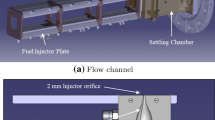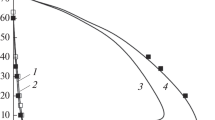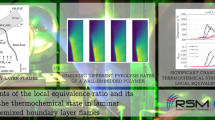Abstract
Laminar premixed flames under laboratory conditions often at reduced pressures are of great interest for combustion chemistry and environmental pollution. Recently, there has been considerable progress in studying the combustion of hydrocarbons, oxygenates, and their mixtures. Methods of laser diagnostics, including cavity ring-down spectroscopy and laser induced fluorescence, combined with a number of mass spectrometry techniques for in situ studies of flames allow measurements of concentrations of major species and intermediate products in flames. The structure of fuel molecules and the effect of fuel composition on the structure of intermediate products were studied from the viewpoint of formation of undesired and potentially harmful combustion products in hydrocarbon and oxygenate flames. Chemiluminescence was studied using data on collisional energy transfer. Low-temperature combustion of strongly diluted mixtures in a flow type reactor was investigated.
Similar content being viewed by others
References
Department of Energy, USA. Information available at: http://www.doe.gov/energysources/fossilfuels.htm (accessed 07/08/08).
Basic Research Needs for Clean and Efficient Combustion of 21st Century Transportation Fuels: Report on the Workshop held by the Office of Basic Energy Sciences of the Department of Energy, Washington, USA, November 2006; http://www.sc.doe.gov/bes/reports/files/CTFrtp.pdf (accessed 07/08/08).
IPCC Fourth Assessment Report Climate Change 2007, Intergovernmental Panel on Climate Change, November 2007; http://www.ipcc.ch/ipccreports/ar4-syr.htm (accessed (07/08/08).
A. Demirbas, “Progress and recent trends in biofuels,” Prog. Energy Combust. Sci. 33, 1–18 (2007).
A. K. Agarwal, “Biofuels (alcohols and biodiesel) applications as fuels for internal combustion engines,” ibid., pp. 233–271.
M. S. Graboski and R. L. McCormick, “Combustion of fat and vegetable oil derived fuels in diesel engines,” Prog. Energ. Combust. Sci., 24, 125–164 (1998).
N. M. Ribeiro, A. C. Pinto, C. M. Quintella, et al., “The role of additives for diesel and diesel blended (ethanol or biodiesel) fuels: A review,” Energ. Fuels, 21, 2433–2445 (2007).
J. A. Miller, M. J. Pilling, and J. Troe, “Unravelling combustion mechanisms through a quantitative understanding of elementary reactions,” Proc. Combust. Inst., 30, 43–88 (2005).
C. S. McEnally, L. D. Pfefferle, B. Atakan, and K. Kohse-Höinghaus, “Studies of aromatic hydrocarbon formation mechanisms in flames: Progress towards closing the fuel gap,” Prog. Energ. Combust. Sci., 32, 247–294 (2006).
H. Richter and J. B. Howard, “Formation of polycyclic aromatic hydrocarbons and their growth to soot — a review of chemical reaction pathways,” Prog. Energ. Combust. Sci., 26, 565–608 (2000).
K. Kohse-Höinghaus, R. S. Barlow, M. Aldén, and J. Wolfrum, “Combustion at the focus: Laser diagnostics and control,” Proc. Combust. Inst., 30, 89–123 (2005).
K. Kohse-Höinghaus and J. B. Jeffries (eds.), Applied Combustion Diagnostics, Taylor and Francis, New York (2002).
S. Cheskis, “Quantitative measurements of absolute concentrations of intermediate species in flames,” Prog. Energ. Combust. Sci., 25, 233–252 (1999).
X. Mercier, E. Therssen, J. F. Pauwels, and P. Desgroux, “Measurements of absolute concentration profiles of C2 in non-sooting and sooting diffusion flames by coupling cavity ring-down spectroscopy and laser induced fluorescence,” Proc. Combust. Inst., 30, 1655–1663 (2005).
J. C. Biordi, “Molecular beam mass spectrometry for studying the fundamental chemistry of flames,” Prog. Energ. Combust. Sci., 3, 151–173 (1977).
T. A. Cool, K. Nakajima, T. A. Mostefaoui, et al., “Selective detection of isomers with photoionization mass spectrometry for studies of hydrocarbon flame chemistry,” J. Chem. Phys., 119, 8356–8365 (2003).
T. A. Cool, A. McIlroy, F. Qi, et al., “Photoionization mass spectrometer for studies of flame chemistry with a synchrotron light source,” Rev. Sci. Instr., 76, 094102 (2005).
C. Huang, L. Wei, B. Yang, et al., “Lean premixed gasoline/oxygen flame studied with tunable synchrotron vacuum UV photoionization,” Energy Fuels, 20, 1505–1513 (2006).
C. A. Taatjes, N. Hansen, A. McIlroy, et al., “Enols are common intermediates in hydrocarbon oxidation,” Science, 308, 1887–1889 (2005).
C. A. Taatjes, N. Hansen, D. L. Osborn, K. Kohse-Höinghaus, T. A. Cool, and P. R. Westmoreland, “Imaging combustion chemistry via multiplexed synchrotronphotoionization mass spectrometry,” Phys. Chem. Chem. Phys., 10, 20–34 (2008).
N. Hansen, T. A. Cool, P. R. Westmoreland, and K. Kohse-Höinghaus, “Recent contributions of flamesampling molecular-beam mass spectrometry to a fundamental understanding of combustion chemistry,” Prog. Energ. Combust. Sci., 35, 168–191 (2009).
N. Hansen, T. Kasper, S. J. Klippenstein, P. R. Westmoreland, M. E. Law, C. A. Taatjes, K. Kohse-Höinghaus, J. Wang, and T. A. Cool, “Initial steps of aromatic ring formation in a laminar premixed fuel-rich cyclopentene flame,” J. Phys. Chem., A, 111, 4081–4092 (2007).
M. E. Law, P. R. Westmoreland, T. A. Cool, J. Wang, N. Hansen, C. A. Taatjes, and T. Kasper, “Benzene precursors and formation routes in a stoichiometric cyclohexane flame,” Proc. Combust. Inst., 31, 565–573 (2007).
N. Hansen, S. J. Klippenstein, P. R. Westmoreland, T. Kasper, K. Kohse-Höinghaus, J. Wang, and T. A. Cool, “A combined ab initio and photoionization mass spectrometric study of polyynes in fuel-rich flames,” Phys. Chem. Chem. Phys., 10, 366–374 (2008).
Y. Li, L. Wei, Z. Tian, B. Yang, J. Wang, T. Zhang, and F. Qi, “A comprehensive experimental study of lowpressure premixed C3-oxygenated hydrocarbon flames with tunable synchrotron photoionization,” Combust. Flame., 152, 336–359 (2008).
T. S. Kasper, P. Osswald, M. Kamphus, and K. Kohse-Höinghaus, “Ethanol flame structure investigated by molecular beam mass spectrometry,” Combust. Flame, 150, 220–231 (2007).
B. Yang, P. Osswald, Y. Li, J. Wang, L. Wei, Z. Tian, F. Qi, and K. Kohse-Höinghaus, “Identification of combustion intermediates in isomeric fuel-rich premixed butanol-oxygen flames at low pressure,” Combust. Flame, 148, 198–209 (2007).
T. A. Cool, J. Wang, N. Hansen, P. R. Westmoreland, F. L. Dryer, Z. Zhao, A. Kazakov, T. Kasper, and K. Kohse-Höinghaus, “Photoionization mass spectrometry and modeling studies of the chemistry of fuel-rich dimethyl ether flames,” Proc. Combust. Inst., 31, 285–293 (2007).
P. Osswald, U. Struckmeier, T. Kaspe, K. Kohse-Höinghaus, J. Wang, T. A. Cool, N. Hansen, and P. R. Westmoreland, “Isomer-specific fuel destruction pathways in rich flames of methyl acetate and ethyl formate and consequences for the combustion chemistry of esters,” J. Phys. Chem., A, 111, 4093–4101 (2007).
T. Kasper, U. Struckmeier, P. Osswald, and K. Kohse-Höinghaus, “Structure of a stoichiometric propanol flame at low pressure,” Proc. Combust. Inst., 32, 1285–1292 (2009).
K. Kohse-Höinghaus, P. Osswald, U. Struckmeier, T. Kasper, N. Hansen, C. A. Taatjes, J. Wang, T. A. Cool, S. Gon, and P. R. Westmoreland, “The influence of ethanol addition on premixed fuel-rich propeneoxygen-argon flames,” Proc. Combust. Inst., 31, 1119–1127 (2007).
J. Wang, U. Struckmeier, B. Yang, T. A. Cool, P. Osswald, K. Kohse-Höinghaus, T. Kasper, N. Hansen, and P. R. Westmoreland, “Isomer-specific influences on the composition of reaction intermediates in dimethyl ether/propene and ethanol/propene flames,” J. Phys. Chem., A, 112, 9255–9265 (2008).
A. Lucassen, P. Osswald, U. Struckmeier, K. Kohse-Höinghaus, T. Kasper, N. Hansen, T. A. Cool, and P. R. Westmoreland, “Species identification in a laminar premixed low-pressure flame of morpholine as a model substance for oxygenated nitrogen-containing fuels,” Proc. Combust. Inst., 32, 1269–1276 (2008).
F. Biagioli, F. Güthe, and B. Schuermans, “Combustion dynamics linked to flame behavior in a partially premixed swirled industrial burner,” Exp. Thermal Fluid Sci., 32, 1344–1353 (2008).
M. C. Drake and D. C. Haworth, “Advanced gasoline engine development using optical diagnostics and numerical modeling,” Proc. Combust. Inst., 31, 99–124 (2007).
M. de Joannon, A. Cavaliere, T. Faravelli, E. Ranzi, P. Sabea, and A. Tregrossi, “Analysis of process parameters for steady operation in methane mild combustion technology,” Proc. Combust. Inst., 30, 2605–2612 (2005).
S. Candel, “Combustion dynamics and control: progress and challenges,” Proc. Combust. Inst., 29, 1–28 (2002).
Y. Hardalupas, M. Orain, C. S. Panoutsos, et al., “Chemiluminescence sensor for local equivalence ratio of reacting mixtures of fuel and air (FLAMESEEK),” Appl. Thermal Eng., 24, 1619–1632 (2004).
P. Gopalakrishnan, M. K. Bobba, and J. M. Seitzman, “Controlling mechanisms for low NOx emissions in a non-premixed stagnation point reverse flow combustor,” Proc. Combust. Inst., 31, 3401–3408 (2007).
J. Kojima, Y. Ikeda, and T. Nakajima, “Basic aspects of OH (A), CH (A) and C2 (d) chemiluminescence in the reaction zone of laminar methane-air premixed flames,” Combust. Flame, 140, 34–45 (2005).
G. P. Smith and C. Park Luque J. “A note on chemiluminescence in low-pressure hydrogen and methanenitrous oxide flames,” Combust. Flame, 140, 385–389 (2005).
J. De Vries, J. M. Hall, S. L. Simmons, M. J. A. Rickard, D. M. Rickard, and E. L. Petersen, “Ethane ignition and oxidation behind reflected shock waves,” Combust. Flame, 150, 137–150 (2007).
A. Schocker, K. Kohse-Höinghaus, and A. Brockhinke, “Quantitative determination of combustion intermediates with cavity ring-down spectroscopy: Systematic study in propene flames near the soot-formation limit,” Appl. Optics., 44, 6660–6672 (2005).
A. T. Hartlieb, B. Atakan, and K. Kohse-Höinghaus, “Temperature measurement in fuel-rich non-sooting low-pressure hydrocarbon flames,” Appl. Phys. B, 70, 435–445 (2000).
W. G. Bessler and C. Schulz, “Quantitative multi-line NO-LIF temperature imaging,” Appl. Phys. B, 78, 519–533 (2004).
M. Kamphus, M. Braun-Unkhoff, and K. Kohse-Höinghaus, “Formation of small PAHs in laminar premixed low-pressure propene and cyclopentene flames: Experiment and modeling,” Combust. Flame, 52, 28–59 (2008).
M. Letzgus, A. Brockhinke, and K. Kohse-Höinghaus, LASKINv2 — A Simulation Program for Time-Resolved LIF-Spectra, Bielefeld University, Chemistry Department, Physical Chemistry 1; http://pc1.unibielefeld.de/laskin (accessed 07/08/08).
A. C. Hindmarsh, P. N. Brown, K. E. Grant, S. L. Lee, R. Serban, D. E. Shumaker, and C. S. Woodward, “SUNDIALS: Suite of nonlinear and differential/algebraic equation solvers,” ACM Trans. Math. Software, 31, 363–396 (2005).
N. Bahlawane, “Kinetics of methane combustion over CVD-made cobalt catalysts,” Appl. Catalysis, B, 67, 168–176 (2006).
H. Richter, S. Granata, W. H. Green, and J. B. Howard, “Detailed modeling of PAH and soot formation in a laminar premixed benzene/oxygen/argon low-pressure flame,” Proc. Combust. Inst., 30, 1397–1405 (2005); The mechanism is available at: http://web.mit.edu/anish/www/MITcomb.html (accessed 07/08/08).
J. Luque and D. R. Crosley, LIFBASE: Database and Spectral Simulation Program, SRI Report No. MP 98-021 (1998); The current version 2.0 is available at: http://www.sri.com/psd/lifbase/ (accessed 07/15/2008).
A. T. Hartlieb, B. Atakan, and K. Kohse-Höinghaus, “Effects of a sampling quartz nozzle on the flame structure of a fuel-rich low-pressure propene flame,” Combust. Flame, 121, 610–624 (2000).
R. J. Cattolica, S. Yoon, and E. L. Knuth, “OH concentration in an atmospheric-pressure methane-air flame from molecular-beam mass spectrometry and laserabsorption spectroscopym” Combust. Sci. Technol., 28, 225–239 (1982).
P. Desgroux, L. Gasnot, J. F. Pauwels, and L. R. Sochet, “Correction of LIF temperature measurements for laser absorption and fluorescence trapping in a flame. Application to the thermal perturbation study induced by a sampling problem” Appl. Phys., B, 61, 401–407 (1995).
J. D. Bittner and J. B. Howard, “Composition profiles and reaction mechanisms in a near-sooting premixed benzene/oxygen/argon flame,” Proc. Combust. Inst., 18, 1105–1116 (1981).
M. Heusing, “Temperatur-imaging durch laserinduzierte Fluoreszenzspektroskopie an Stickstoffmonoxidm” Bachelor Thesis, Bielefeld University, July 2008.
D. Hu, M. Braun-Unkhoff, and P. Frank, “Modeling study of soot formation at high pressures,” Combust. Sci. Technol., 149, 79–94 (1999).
A. Lamprecht, B. Atakan, and K. Kohse-Höinghaus, “Fuel-rich flame chemistry in low-pressure cyclopentene flames,” Proc. Combust. Inst., 28, 1817–1824 (2000).
C. K. Westbrook, W. J. Pitz, P. R. Westmoreland, et al., “A detailed chemical kinetic reaction mechanism for oxidation of four small alkyl esters in laminar premixed flames,” Proc. Combust. Inst., 32, 221–228 (2008).
J. Wu, K. H. Song, T. Litzinger, S. Y. Lee, R. Santoro, M. Linevsky, M. Colket, and D. Liscinsky, “Reduction of PAH and soot in premixed ethylene-air flames by addition of ethanol,” Combust. Flame, 144, 675–687 (2006).
Z. Zhao, M. Chaos, A. Kazakov, and F. L. Dryer, “Thermal decomposition reaction and com-prehensive kinetic model of dimethyl ether,” Int. J. Chem. Kin., 40, 1–18 (2008).
S. Dooley, H. J. Curran, and J. M. Simmie “Autoignition measurements and a validated kinetic model for the biodiesel surrogate, methyl butanoate,” Combust. Flame, 153, 2–32 (2008).
S. Gaïl, S. M. Sarathy, M. J. Thomson, P. Diévart, and P. Dagaut, “Experimental and chemical kinetic modeling study of small methyl esters oxidation: Methyl (E)-2-butenoate and methyl butanoate,” Combust. Flame, 155, 635–650 (2008).
A. Brockhinke, U. Lenhard, A. Bülter, and K. Kohse-Höinghaus, “Energy transfer in the OH A2Σ+ state: The role of polarization and of multi-quantum energy transfer,” Phys. Chem. Chem. Phys., 7, 874–881 (2005).
U. Struckmeier, N. Bahlawane, and K. Kohse-Höinghaus, Unpublished results (2008).
C. S. McEnally and L. D. Pfefferle, “The effects of dimethyl ether and ethanol on benzene and soot formation in ethylene nonpremixed flames,” Proc. Combust. Inst., 31, 603–610 (2007).
C. S. McEnally and L. D. Pfefferle, Fuel decomposition and hydrocarbon growth processes for oxygenated hydrocarbons: Butyl alcohols,” Proc. Combust. Inst., 30, 1363–1370 (2005).
Author information
Authors and Affiliations
Corresponding author
Additional information
__________
Translated from Fizika Goreniya i Vzryva, Vol. 45, No. 4, pp. 5–21, July–August, 2009.
Rights and permissions
About this article
Cite this article
Kohse-Höinghaus, K., Brockhinke, A. Experimental and numerical methods for studying the flame structure. Combust Explos Shock Waves 45, 349–364 (2009). https://doi.org/10.1007/s10573-009-0046-0
Received:
Published:
Issue Date:
DOI: https://doi.org/10.1007/s10573-009-0046-0




